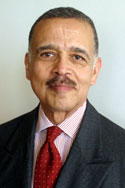ARCHIVES
OF EDITORIALS
June 9, 2005
A growing divide
At a celebration of the 50th anniversary of Brown
v. Board of Education on May 17, 2004, Bill Cosby went to the
podium and assailed the “lower economic people” of
the race for not doing enough to get ahead. His remarks evoked
great support from some African Americans while others were extremely
critical.
The most articulate and scholarly criticism was prepared by Michael
Eric Dyson in his recently published book “Is Bill Cosby
Right (Or Has the Black Middle Class Lost Its Mind?).” Dyson
is the Avalon Foundation professor in the Humanities at the University
of Pennsylvania.
The essence of Dyson’s criticism is that Cosby is critical
of blacks, but he fails to excoriate whites for their racist policies
which contributed substantially to the deterioration of life in
this country for African Americans. While Dyson does not use the
term, his criticism has always been defined as “blaming
the victim,” a concept set forth by William Ryan in by book
of that name. Blacks who “blame the victim” are often
falsely described as being out of touch with reality.
According to Dyson, Cosby’s remarks are typical of the attitude
of the aristocrats, those blacks who have succeeded in America’s
racially hostile environment. Dyson asserts that these super-blacks
are now embarrassed by the language, dress and conduct of low-income
blacks.
While Dyson suggests that there might be a generational divide
provoking this conflict, this perspective is not adequately explored.
The reason might be that Dyson is only 46 years old while Cosby
is 67. The worlds they both faced in their youth were entirely
different.
Racial apartheid was alive and well in America during Cosby’s
youth. White colleges in the South did not admit black students,
and colleges in the North operated on very strict racial quotas.
Despite rampant discrimination in employment, blacks held on to
the American dream and went to college. It was not at all unusual
to find black college graduates working as Pullman Porters or
US postal clerks. There was no affirmative action.
Most blacks held menial jobs and struggled to maintain a reasonable
standard of living for their families. Home ownership was not
easy to come by because banks tended to redline the areas where
blacks lived. As a result, conventional mortgages were not available.
Despite these adverse conditions, many black communities were
culturally rich, supportive environments. Residents were respectful
and courteous to one another. While there were personal conflicts,
residents were generally not fearful of one another.
This was the generation of African Americans who fought the civil
rights battles that led to passage of the Civil Rights Act of
1964 and the Voting Rights Act of 1965. Their efforts created
the opportunities that led to the growth of the black middle class.
Bishop T. D. Jakes states in Dyson’s book, “conditions
for blacks are drastically improved; and as overt racism recedes,
blacks increasingly have the light to more clearly distinguish
our self-inflicted wounds from the social bruising of our bludgeoned
history.” The problem is that few openly engage in such
introspection. The blame for deviant black behavior is almost
always attributed to white injustice.
It is no wonder, then, that Cosby would denounce “the poverty
pimps and the victim pimps [who] keep telling the victim to stay
where they are.” Cosby wants to reinstate the tough standards
of his youth. Dyson, who is profoundly sympathetic to the plight
of blacks, came of age in a different era, when standards had
all but disappeared.
There is a philosophical divide between Cosby and Dyson that cannot
be bridged with epithets.
Home
Page

